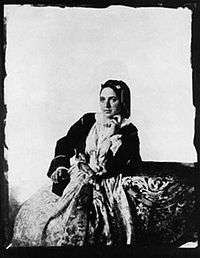Milica Stojadinović-Srpkinja

Milica Stojadinovic-Srpkinja (Serbian Cyrillic: Милица Стојадиновић Српкиња, pronounced [mîlitsa stɔjadǐːnɔv̞itɕ sr̩̂pkiɲa]) (1828, Bukovac, Petrovaradin – 1878, Belgrade) was arguably the greatest female Serbian poet of the 19th century.
Biography
She was born to a family of a Serb Orthodox Church parish priest, and received acclaim for her patriotic poetry already as a teen; she expanded to other aspects of Romanticist poetry as she grew older. In her hometown of Bukovac her character was shaped; here she imbibed that passionate love of country scenes and country life which neither absence, politics nor dissipation could uproot. Here she learnt to understand the ways and thoughts of the peasant folk, and laid up that rich store of scenes and characters which a marvelously retentive memory enabled her to draw upon at will. The progress of her mind during these early years well deserves to be recorded.
Education, in the strict sense of the word, she had very little. Except for a lower Gymnasium education, she was mostly self-taught, and yet she was greatly appreciated in her lifetime by poets and writers much more soundly academic than herself, such as Petar II Petrović Njegoš, Branko Radičević, Ivan Mažuranić, and Ljubomir Nenadović. When Njegoš first met her in Vienna, he said: I'm a poet, she is a poetess. Were I not a bishop, Montenegro would now have a princess (quoted from Milovan Djilas's Njegoš: Poet, Prince, Bishop, published by Harcourt, Brace, Jovanovich, New York, 1966, p. 242).
Her first book of poems—Pesme (Poems)—was published in 1850, and, later on, two expanded editions were issued in 1855 and 1869. She also wrote a diary entitled U Fruskoj gori 1854 (In Fruska Gora: 1854), in three volumes, published in 1861, 1862 and 1866. She spoke German fluently, and even translated articles from German magazines for Serbian newspapers. Milica is considered the first woman war correspondent in Serbia. On the 15th of June 1862 she was a witness to a what began as a skirmish but developed into a major conflict between the Serbian Gendarmerie and Turkish troops at Belgrade. The incident at Čukur Fountain (Čukur česma) began when a boy with a jug was shot and killed by a Turkish soldier which resulted in the bombardment of the Serbian capital by Turkish artillery ensconced in the Kalemegdan fortress.
As her fame spread beyond the confines of Serbian culture of the Austrian Empire, Prince Mihailo Obrenović would invite her to court when she came to Belgrade and Vienna-based anthropologist and poet Johann Gabriel Seidl devoted a poem to her.
She corresponded extensively with writers Đorđe Rajković (1825–1886), Ljubomir Nenadović, Vuk Stefanović Karadžić and his daughter Wilhelmine/Mina, Božena Němcová, and with Ludwig August von Frankl. (In 1891 an almanach Die Dioskuren was issued in Vienna by Ludwig von Frankl with a collection of letters written by Milica Stojadinović).
Her work, though, has been mostly out of the public eye and almost forgotten except by literary experts for most of the 20th century, first during fin-de-siècle modernist poeticism as an outdated poetic form of pre-1870s, and later, under Communist rule as an unacceptable expression of patriotism for only one of the six nations of Yugoslavia (namely: Serbian).
After Josip Broz Tito's death the awareness of her work was revived, and in the last quarter of a century a four-day poetry memorial is convened annually in Novi Sad in her honour, where a poetry prize bearing her name is awarded to prominent poets from Serbia.
In a book on the history of Serbian literature, Istorija srpske književnosti, written by Jovan Deretić, she is mentioned numerous times as a figure who fascinated contemporaries not only because of her poetry, but also because of her unusual beauty.... but whose verses .... have more moral preaching and patriotic thoughts than real poetry. She expressed better her personality in her diary "U Fruskoj gori" than in her poems... (Deretić, 1983, p. 328)
Milica's diary was reprinted in 1985 by the publishing house Prosveta in Belgrade; her Prepiska Milica Stojadinovic Srpkinja sa Vukom i Minom / Correspondence with Vuk and Mina Karadzic was published in 1987 (Knizevna zajednica Novog Sada); and four years later her "Other Letters to Contemporaries" were published in a book, edited by Radmilla Gikic. A selection of her poems was published in 1995 by Papirus in Novi Sad. After 2000, the reception of Milica Stojadinović's work gained new momentum from women's studies in the works by Celia Hawkesworth, Magdalena Koch, Slavica Garonja, and Biljana Dojčinović.
References
- Jovan Skerlić, Istorija Nove Srpske Književnosti / History of Modern Serbian Literature (Belgrade, 1914, 1921), p. 208. Her biography was translated from Skerlić's Serbian into English for this entry in the Wikipedia.